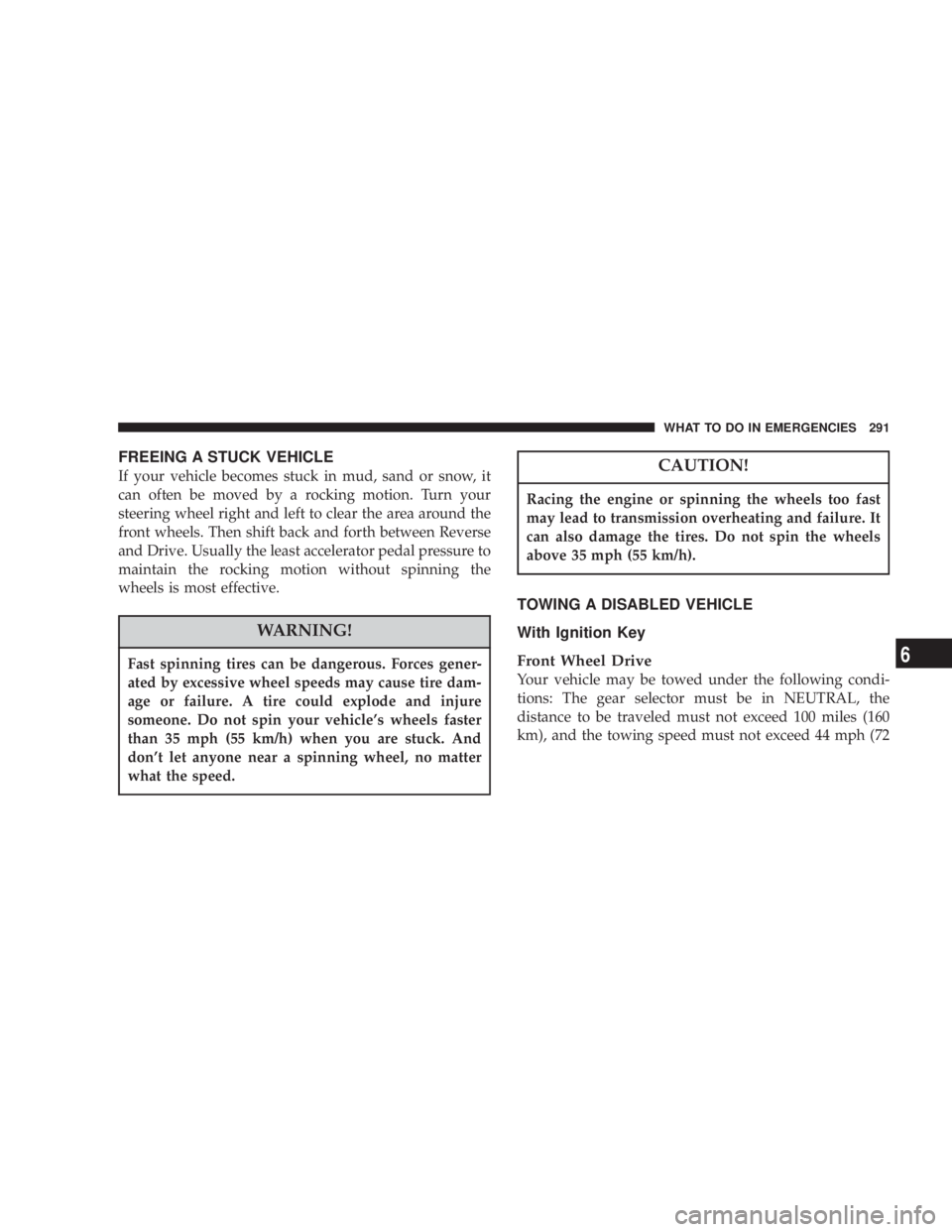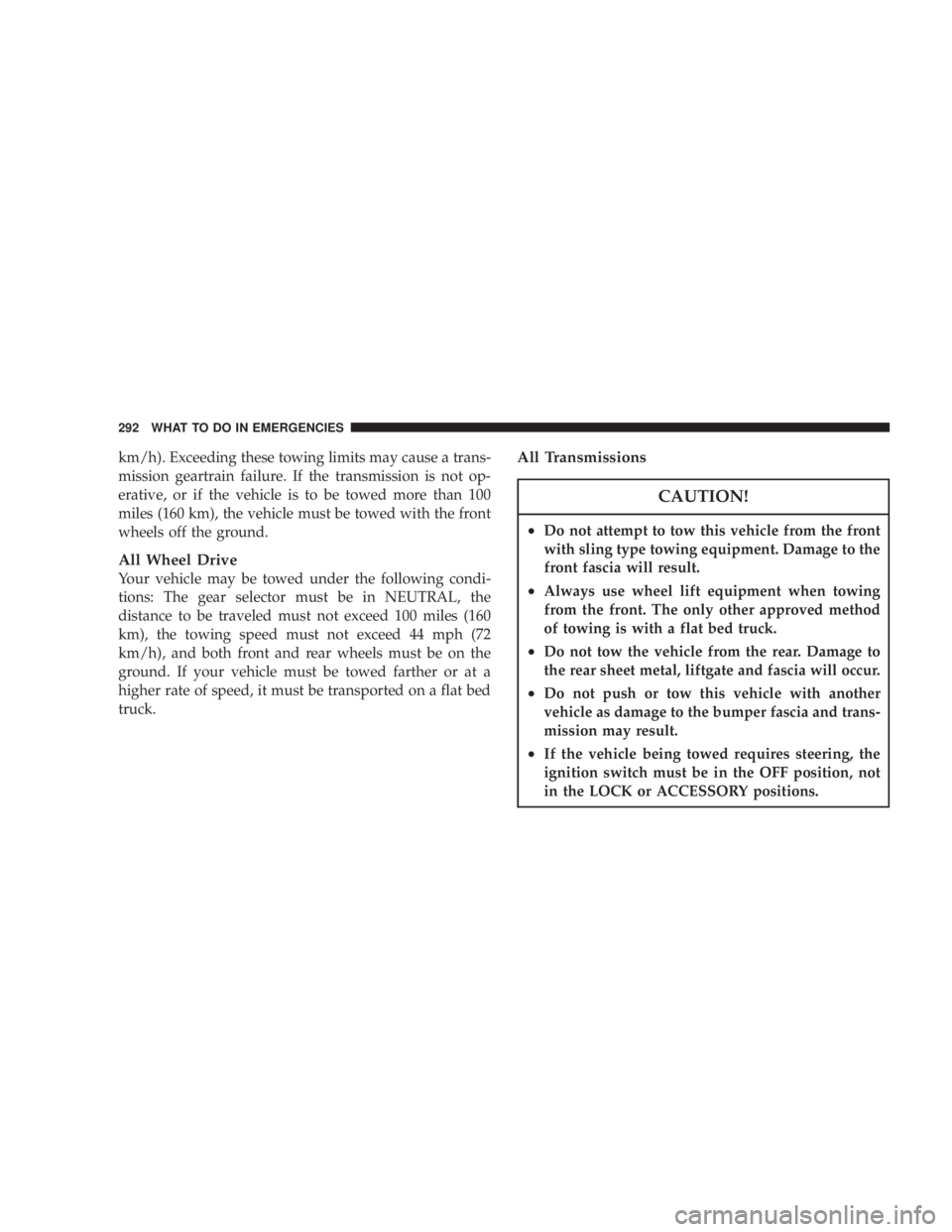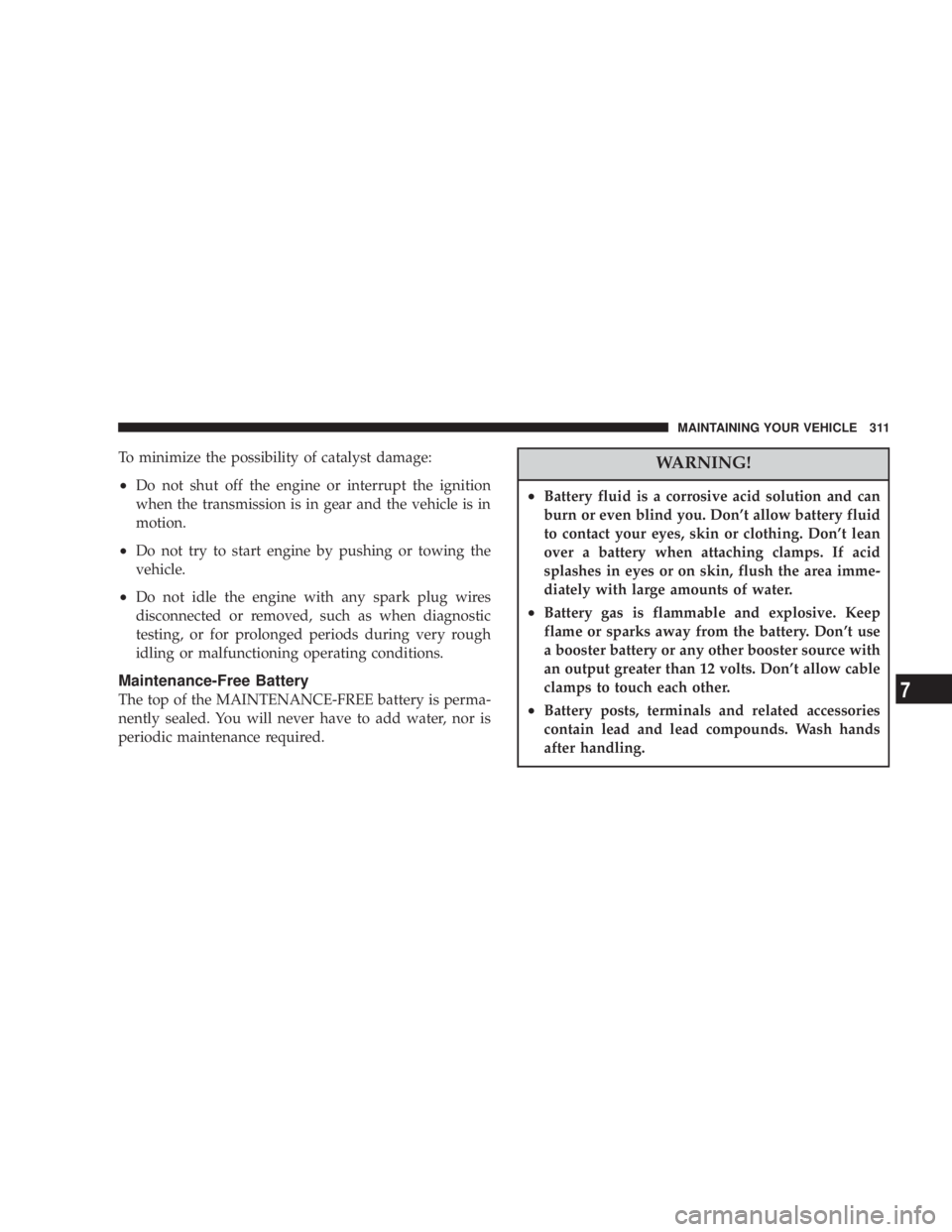Page 279 of 397
WHAT TO DO IN EMERGENCIESCONTENTS m Hazard Warning Flasher ..................280
m If Your Engine Overheats .................281
m Jacking And Tire Changing ................282
N Jack Location ........................283
N Spare Tire Stowage ....................283
N Preparations For Jacking ................284
N Jacking Instructions ....................285
m Jump-Starting Procedures If Battery Is Low ....288
m Driving On Slippery Surfaces ..............290
N Acceleration .........................290 N Traction ............................290
m Freeing A Stuck Vehicle ..................291
m Towing A Disabled Vehicle ................291
N With Ignition Key .....................291
N Without The Ignition Key ...............293
N Towing This Vehicle Behind Another Vehicle
(Flat Towing With All Four Wheels On The
Ground) ............................293
N Towing This Vehicle Behind Another Vehicle
With A Tow Dolley ....................293
6
Page 291 of 397

FREEING A STUCK VEHICLE
If your vehicle becomes stuck in mud, sand or snow, it
can often be moved by a rocking motion. Turn your
steering wheel right and left to clear the area around the
front wheels. Then shift back and forth between Reverse
and Drive. Usually the least accelerator pedal pressure to
maintain the rocking motion without spinning the
wheels is most effective.
WARNING!Fast spinning tires can be dangerous. Forces gener-
ated by excessive wheel speeds may cause tire dam-
age or failure. A tire could explode and injure
someone. Do not spin your vehicle's wheels faster
than 35 mph (55 km/h) when you are stuck. And
don't let anyone near a spinning wheel, no matter
what the speed. CAUTION!Racing the engine or spinning the wheels too fast
may lead to transmission overheating and failure. It
can also damage the tires. Do not spin the wheels
above 35 mph (55 km/h).
TOWING A DISABLED VEHICLE
With Ignition Key
Front Wheel Drive
Your vehicle may be towed under the following condi-
tions: The gear selector must be in NEUTRAL, the
distance to be traveled must not exceed 100 miles (160
km), and the towing speed must not exceed 44 mph (72 WHAT TO DO IN EMERGENCIES 291
6
Page 292 of 397

km/h). Exceeding these towing limits may cause a trans-
mission geartrain failure. If the transmission is not op-
erative, or if the vehicle is to be towed more than 100
miles (160 km), the vehicle must be towed with the front
wheels off the ground.
All Wheel Drive
Your vehicle may be towed under the following condi-
tions: The gear selector must be in NEUTRAL, the
distance to be traveled must not exceed 100 miles (160
km), the towing speed must not exceed 44 mph (72
km/h), and both front and rear wheels must be on the
ground. If your vehicle must be towed farther or at a
higher rate of speed, it must be transported on a flat bed
truck. All Transmissions
CAUTION!² Do not attempt to tow this vehicle from the front
with sling type towing equipment. Damage to the
front fascia will result.
² Always use wheel lift equipment when towing
from the front. The only other approved method
of towing is with a flat bed truck.
² Do not tow the vehicle from the rear. Damage to
the rear sheet metal, liftgate and fascia will occur.
² Do not push or tow this vehicle with another
vehicle as damage to the bumper fascia and trans-
mission may result.
² If the vehicle being towed requires steering, the
ignition switch must be in the OFF position, not
in the LOCK or ACCESSORY positions.292 WHAT TO DO IN EMERGENCIES
Page 293 of 397
If it is necessary to use the accessories while being towed
(wipers, defrosters, etc.), the key must be in the ON
position, not the ACCESSORY position. Make certain the
transmission remains in NEUTRAL.
Without The Ignition Key
Special care must be taken when the vehicle is towed
with the ignition in the LOCK position. The only ap-
proved method of towing with out the ignition key is
with a flat bed truck. Proper towing equipment is neces-
sary to prevent damage to the vehicle. TOWING THIS VEHICLE BEHIND ANOTHER
VEHICLE (Flat towing with all four wheels on the
ground)
Flat towing of vehicles equipped with an automatic
transmission, is only permitted within the limitations
described in this section.
TOWING THIS VEHICLE BEHIND ANOTHER
VEHICLE WITH A TOW DOLLEY
The manufacture does not recommend that you tow an
All-Wheel Drive (AWD) or front wheel drive vehicle on a
tow dolley. Vehicle damage may occur. WHAT TO DO IN EMERGENCIES 293
6
Page 300 of 397

ONBOARD DIAGNOSTIC SYSTEM Ð OBD II
Your vehicle is equipped with a sophisticated onboard
diagnostic system called OBD II. This system monitors
the performance of the emissions, engine, and automatic
transmission control systems. When these systems are
operating properly, your vehicle will provide excellent
performance and fuel economy, as well as engine emis-
sions well within current government regulations.
If any of these systems require service, the OBD II system
will turn on the ªMalfunction Indicator Light.º It will
also store diagnostic codes and other information to
assist your service technician in making repairs. Al-
though your vehicle will usually be drivable and not
need towing, see your dealer for service as soon as
possible. CAUTION!Prolonged driving with the ªMalfunction Indicator
Lightº on could cause further damage to the emis-
sion control system. It could also affect fuel economy
and driveability. The vehicle must be serviced before
any emissions tests can be performed.
If the ªMalfunction Indicator Lightº is flashing
while the engine is running, severe catalytic con-
verter damage and power loss will soon occur. Im-
mediate service is required.300 MAINTAINING YOUR VEHICLE
Page 305 of 397

Change Engine Oil
Road conditions and your kind of driving affects the
interval at which your oil should be changed. Check the
following list to see if any apply to you.
² Day or night temperatures are below 32ÉF (0ÉC).
² Stop and Go driving.
² Extensive engine idling.
² Driving in dusty conditions.
² Short trips of less than 10 miles (16 km).
² More than 50% of your driving is at sustained high
speeds during hot weather, above 90ÉF (32ÉC).
² Trailer towing.
² Taxi, Police or delivery service (commercial service).
² Off-Road or desert operation. If ANY of these apply to you, then change your engine oil
at every interval shown in schedule ªBº of the ªMainte-
nance Schedulesº section of this manual.
If none of these apply to you, then change your engine oil
at every interval shown on schedule ªAº of the ªMain-
tenance Schedulesº section of this manual
NOTE: Under no circumstances should oil change in-
tervals exceed 6000 miles (10 000 km) or 6 months
whichever comes first.
Engine Oil Selection
For best performance and maximum protection under all
types of operating conditions, the manufacture only
recommends engine oils that are API certified and meet
the requirements of DaimlerChrysler Material Standard
MS-6395. Use Mopar or an equivalent oil meeting the
specification MS-6395. MAINTAINING YOUR VEHICLE 305
7
Page 311 of 397

To minimize the possibility of catalyst damage:
² Do not shut off the engine or interrupt the ignition
when the transmission is in gear and the vehicle is in
motion.
² Do not try to start engine by pushing or towing the
vehicle.
² Do not idle the engine with any spark plug wires
disconnected or removed, such as when diagnostic
testing, or for prolonged periods during very rough
idling or malfunctioning operating conditions.
Maintenance-Free Battery
The top of the MAINTENANCE-FREE battery is perma-
nently sealed. You will never have to add water, nor is
periodic maintenance required. WARNING!² Battery fluid is a corrosive acid solution and can
burn or even blind you. Don't allow battery fluid
to contact your eyes, skin or clothing. Don't lean
over a battery when attaching clamps. If acid
splashes in eyes or on skin, flush the area imme-
diately with large amounts of water.
² Battery gas is flammable and explosive. Keep
flame or sparks away from the battery. Don't use
a booster battery or any other booster source with
an output greater than 12 volts. Don't allow cable
clamps to touch each other.
² Battery posts, terminals and related accessories
contain lead and lead compounds. Wash hands
after handling. MAINTAINING YOUR VEHICLE 311
7
Page 328 of 397

5. Remove the dipstick and determine if the fluid is hot
or warm. Hot fluid is approximately 180ÉF (82ÉC), which
is the normal operating temperature after the vehicle has
been driven at least 15 miles (24 km). The fluid cannot be
comfortably held between the finger tips. Cold is when
the fluid is below 80ÉF (27ÉC).
6. Wipe the dipstick clean and reinsert until seated.
Remove dipstick and note reading.
a. If the fluid is hot, the reading should be in the
crosshatched area marked ªHOTº (between the upper
two holes in the dipstick).
b. If the fluid is cold, the fluid level should be between
the lower two holes in the area marked ªCOLDº.
If the fluid level indicates low, add sufficient fluid to
bring to the proper level. CAUTION!Do not overfill. Dirt and water in the transmission
can cause serious damage. To prevent dirt and water
from entering the transmission after checking or
replenishing fluid, make certain that the dipstick cap
is reseated properly.
Fluid and Filter Changes
Automatic transmission fluid should be changed on all
transmissions as follows:
Normal Usage Ð No change necessary
Severe Usage (fluid and filter) Ð 60,000 miles (96 000 km)
Severe Usage is defined as:
² Police, taxi, limousine, commercial type operation, or
trailer towing where the vehicle is driven regularly for
more than 45 minutes of continuous operation.328 MAINTAINING YOUR VEHICLE